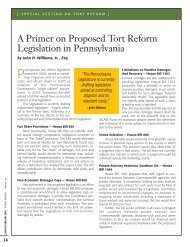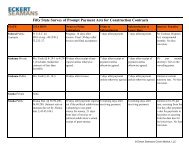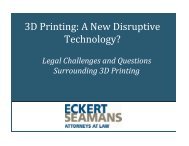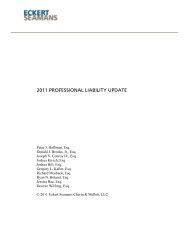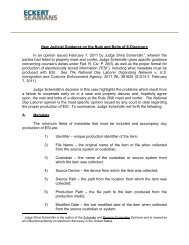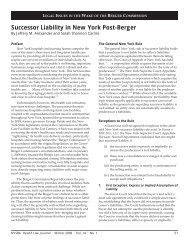2012 PROFESSIONAL LIABILITY UPDATE - Eckert Seamans
2012 PROFESSIONAL LIABILITY UPDATE - Eckert Seamans
2012 PROFESSIONAL LIABILITY UPDATE - Eckert Seamans
You also want an ePaper? Increase the reach of your titles
YUMPU automatically turns print PDFs into web optimized ePapers that Google loves.
investigation. The retention letter sent to the accounting firm stated “[i]t is understoodthat P&W is being retained to assist K&L as a financial expert related to the specialinvestigation of certain transactions involving Le-Nature’s, Inc. . . . . P&W shall providegeneral consulting, financial, accounting, and investigative or other advice as requested byK&L to assist it in rendering legal advice to Le-Nature’s. . . .” In addition, the letter’ssection governing payment stated, inter alia, “P&W will render monthly invoices to K&L.K&L will then include our charges as part of its regular monthly invoices to LaNature’s.”After the fraud was uncovered, bankruptcy proceedings were instituted. The courtcreated the Le-Nature’s Liquidation Trust, which held Le-Nature’s assets and property.The trustee of the trust initiated the action against the defendants on behalf of Le-Nature’screditors.The Court found no attorney-client relationship existed between the defendant andthe creditors. Kirschner, 2010 WL 5504811. The Court distinguished the case from ahypothetical in which a company appoints a special committee to conduct an investigationinto whether a vice president is purchasing property at inflated rates from her family andto report its results to the entire board. In the hypothetical, the committee hired a law firmwhich failed to discover the vice president’s activities, which were discovered three yearslater. The court noted that in the hypothetical the corporation could bring an actionagainst the law firm because the alleged misconduct impacted each shareholder, noshareholder was involved in the misconduct, and the law firm knew it was being retained toprotect each shareholder from future misconduct. In the present case, however, there weretwo groups of equity holders, Podlucky and the investors. The law firm understood it wasbeing hired to protect only the investors, who were not involved in the operation of thecompany. Therefore, the investors were the only parties that could sue.The Court also found no implied attorney-client relationship existed. It noted animplied “attorney-client relationship exists, absent an express contract, where (1) thepurported client seeks advice or assistance from the attorney; (2) the advice is within theattorney's professional competence; (3) the attorney expressly or implicitly agrees torender such assistance; and (4) the putative client reasonably believes the attorney wasrepresenting it. Kirschner, 2010 WL 5504811 (citing Cost v. Cost, 677 A.2d 1250, 1254 (Pa.Super. 1996)). The court found no implied relationship because an express contract existedand the investigation was not conducted to protect Podlucky’s interests. Rather, it wasconducted to protect the interest of the remaining equity holders.In Solow v. Berger, No. 10-CV-2950, 2011 WL 1045098 (E.D. Pa. Mar. 22, 2011), theplaintiffs alleged a legal malpractice claim against an attorney who prepared a will for theplaintiffs’ step-grandmother. The will did not name the plaintiffs as beneficiaries. TheUnited States District Court for the Eastern District of Pennsylvania dismissed the casepursuant to the probate exception to federal subject matter jurisdiction. The court foundthat even if the probate exception did not apply, the legal malpractice claim would bedismissed for failure to state a claim. The court found no attorney-client relationshipexisted between the plaintiffs and the defendant. The court noted “certain non-client thirdpartybeneficiaries can bring legal malpractice claims on a breach-of-contract theory.”157




